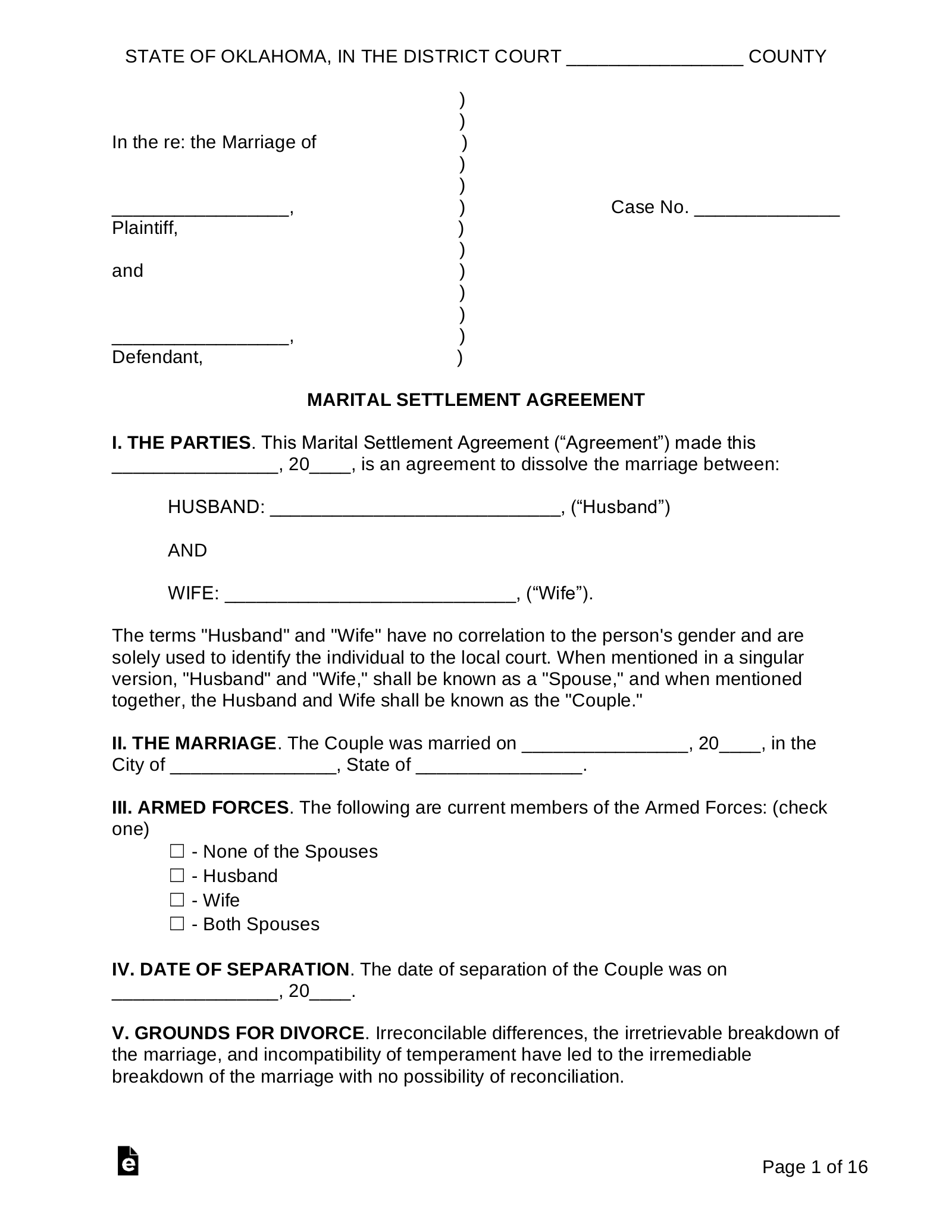Updated August 29, 2023
An Oklahoma marital settlement agreement is a legal document for spouses who wish to resolve certain issues regarding the dissolution of their marriage. These issues include child custody, visitation, and support, alimony, as well as alimony and asset division. This agreement can be a helpful tool for spouses who can work together, either alone or with the help of attorneys or a mediator, so they may come to fair and reasonable terms for separation or divorce. The execution of the legally binding document does not, in itself, signify a legal divorce or separation. In order to dissolve a marriage or legally separate, the spouses will have to go through the appropriate court proceedings.
Table of Contents |
Divorce Laws
Statutes – Title 43. Marriage (Divorce and Alimony)
Alimony (§ 43-121(B) and § 43-134) – Alimony may be awarded to either spouse by the court in the form of a dollar amount or the division of property, which will be provided in a lump sum or periodic payments. There are no specific guidelines that Oklahoma courts use to determine the amount and length of alimony payments due to the fact that permanent or long-term alimony is not awarded very often. However, if they do order alimony of this nature, they will consider the length of the marriage, income and liabilities, earning capacity, health and age, and the standard of living established during marriage, among other factors.
Alimony Calculator – Law Offices of Evan. A Taylor
Child Support (§ 43-118D(A)) – Child support is calculated by combining the parents’ gross income, and then referring to the Child Support Guideline Schedule provided in § 43-119.
Child Support Calculator – Oklahoma Department of Human Services
Division of Property (§ 43-121(B)) – Oklahoma courts use the equitable distribution law to divide the marital property between the spouses during the divorce proceedings. Property acquired during the marriage will be split between the spouses in a manner deemed fair and reasonable by the court. However, the court may set aside part of a spouse’s separate property for the support of the other spouse or the children of the marriage.
Grounds for Divorce (§ 43-101) – Oklahoma courts will order a decree for divorce on any of the following grounds:
- Abandonment for one (1) year
- Adultery
- Impotency
- Wife was pregnant with another man’s child at the time of marriage
- Extreme Cruelty
- Fraudulent contract
- Incompatibility
- Habitual drunkenness
- Gross neglect of duty
- Imprisonment for a felony
- The procurement of a final divorce in another state that is not valid in Oklahoma
- Insanity for a period of five (5) years
Interim Support (§ 43-110(B)(1)) – Temporary orders for spousal support, or “maintenance,” may be granted by the court by a spouse seeking relief. A hearing must take place and the non-requesting party must be given notice of the hearing at least five (5) days beforehand.
Residency (§ 43-102(A)) – To file for divorce in Oklahoma, either spouse (petitioner or respondent) must have lived in the state for at least six (6) months prior to the filing of the action. Furthermore, the petitioner (spouse filing the divorce action) must be a resident of the county in which they are filing for at least thirty (30) days before filing (§ 43-103(A)(1)).
Divorce Forms
- Where to File – Oklahoma District Court
- Filing Fee – Between $210-265
- How Long Does it Take? Ten (10) or (90) days
Uncontested Divorce with No Children:
- Petition for Dissolution of Marriage
- Civil Cover Sheet
- Summons
- Decree of Dissolution of Marriage
- Motion to Set Matter for Hearing
- Order Setting Matter on Motion
- Motion for Default Judgment (if applicable)
- Order to Set for Hearing on Default Judgment (if applicable)
Uncontested Divorce With Children:
- Petition for Dissolution of Marriage
- Civil Cover Sheet
- Summons
- Decree of Dissolution of Marriage
- Child Support Computation Form
- Joint Custody Plan
- Motion to Set Matter for Hearing
- Order Setting Matter on Motion
- Motion for Default Judgment (if applicable)
- Order to Set for Hearing on Default Judgment (if applicable)
How to File for Divorce in Oklahoma (6 steps)
- Settlement Agreement
- Petition
- Divorce Decree
- Default Judgment (If Applicable)
- Motion to Set Hearing
- Hearing
1. Settlement Agreement

An uncontested divorce in Oklahoma is an action petitioned with the district court in the county in which the petitioning spouse has resided for thirty (30) days. Either spouse has to have lived in the state of Oklahoma for at least six (6) months prior to filing the divorce action. Also called a no-fault divorce, an uncontested divorce can be filed on the grounds of incompatibility and will require both spouses to be in agreement regarding all issues relating to their divorce, such as property division, alimony, and child support. These issues and all other pertinent affairs can be settled in a Marital Settlement Agreement.
2. Petition
3. Divorce Decree

When both spouses are in agreement with the divorce and all related matters, they can complete a Decree of Dissolution of Marriage together (Without Children | With Children). This document summarizes issues relating to the divorce such as property division, debts and liabilities, alimony, and child support/custody/visitation (if applicable). Furthermore, if a spouse wishes to revert to their birth name, they are able to add this in the decree under Article 13 of the document. If they choose to change their name after the divorce has been ordered, it may be more time-consuming. If the parties have any minor children, they will also need to complete a Child Support Computation Form and a Joint Custody Plan (only if the spouses are requesting joint custody).
If the non-petitioning spouse (“respondent”) is not willing to execute the Decree for Divorce, the petitioner will have to serve them with the Petition and Summons (Step 4 – Default Judgment).
4. Default Judgment (If Applicable)

In situations where the respondent spouse does not sign the decree for divorce, they must be served copies of the petition and summons. They have twenty (20) days to file an answer, which would make the divorce action a contested divorce. Legal counsel should be sought if the respondent files an answer. If they don’t file an answer, the petitioner can request a default judgment by completing the Motion for Default Judgment form and Order to Set for Hearing on Default Judgment form. These forms must be filed with the court clerk, who will pass them along to the judge for their signature. A date for a default hearing will be set, and the petitioner should prepare the appropriate Decree of Dissolution of Marriage (Without Children | With Children). Since the other spouse needn’t be involved due to their failure to answer the petition, the petitioner can complete the document as they see fit. At the default hearing, the judge will look over all documents and ask the petitioner pertinent questions. If all affairs are in order, the judge will sign the decree to finalize the divorce.
5. Motion to Set Hearing
6. Hearing
- Decree of Dissolution of Marriage (Without Children | With Children)
- Child Support Computation Form
- Joint Custody Plan
The judge will review the forms and ask the parties any questions they deem relevant. If the judge is satisfied with the forms and the spouses’ answers, they will sign the Decree to finalize the divorce.
Note: The parents may be required by judge’s order to take the Helping Children Cope with Divorce class with the Family & Children’s Services.


